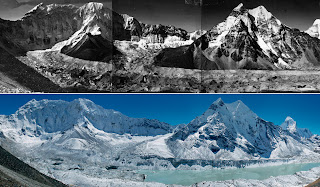The Critical Condition of Himalayan Water Storage
The Critical Condition of Himalayan Water Storage
 The Hindu-Kush Himalayan region is the most extensive high altitude areas on earth, and its largest mass areas covered by glaciers, the permafrost out side the polar regions, is known as the "Third Pole". These Mountain areas are now recognised to be a hotspot of Climate Change, but they have still received significantly less attention than the Antarctic and Arctic. The region's ranges starts from the foothills to high mountain the Mt. Everest 8848m. high. They have many variations of climates within the regions with a wide spectrum of ecological zones and with a great socioeconomic potential. When we consider case studies in term of biodiversity hotspot, they contain significantly unique array of plants and animals of global important. More clearly it is known to all of us that the large masses of glacier in high maintain, wetlands, Langland's and forests provide valuable ecosystem services such as plant based production, soil retention, climate regulation and carbon seizure. The climate was normally regulated, and the rivers flow was also normal such that there was not any flood and damages. But, due to the present climate which is known as changing of climate or climate change, it has effected in all parts of the natural regulations, environments and whole ecosystem.
The Hindu-Kush Himalayan region is the most extensive high altitude areas on earth, and its largest mass areas covered by glaciers, the permafrost out side the polar regions, is known as the "Third Pole". These Mountain areas are now recognised to be a hotspot of Climate Change, but they have still received significantly less attention than the Antarctic and Arctic. The region's ranges starts from the foothills to high mountain the Mt. Everest 8848m. high. They have many variations of climates within the regions with a wide spectrum of ecological zones and with a great socioeconomic potential. When we consider case studies in term of biodiversity hotspot, they contain significantly unique array of plants and animals of global important. More clearly it is known to all of us that the large masses of glacier in high maintain, wetlands, Langland's and forests provide valuable ecosystem services such as plant based production, soil retention, climate regulation and carbon seizure. The climate was normally regulated, and the rivers flow was also normal such that there was not any flood and damages. But, due to the present climate which is known as changing of climate or climate change, it has effected in all parts of the natural regulations, environments and whole ecosystem.
In case of Nepal contest presently there is nothing normal such as the flow of river is either flood or dry, and the rainfall pattern is also changing, it is either heavy rainfall or there is no rainfall for long time. The monsoon period is also changing, sometimes it starts from July and heavy rainfall during August, and sometimes it starts from late May. It is inappropriate situation for the farmers who are cultivating in dry slope farmland. It is inappropriate situation for the farmers who are cultivating in dry slope farmland.
The Himalayan ranges form a barrier to the easterly monsoon winds, and these Himalayan ranges with large masses of glacier are the origin of the ten of the largest rivers in Asia. The huge amount of the water storage capacity of the mountains provides a lifeline for more than 1.3 billion peoples living in the region and down stream; The whole ecosystems are related to depend directly or indirectly on Himalayan waters.
Generally we are experiencing temperature increasing or warming trend for the last 30 years. The mean maximum temperature in Nepal is increased by 0.06 degree Celsius per year between 1977 to 2000. Similarly, the Tibetan Plateau has experienced warming in the range of 0.02 degree Celsius to 0.03 degree Celsius per year over the last fifty years (Yao et al. 2006). Based on the regional climate models, it is predicted that the temperature on the Indian Sub-continent will raise between 3.5 degree Celsius and 5.5 degree Celsius by 2100 (Rupa Kumar et al.2006). Monsoon rainfall in India and Nepal are highly correlated with large scale climatological phenomena such as El Nino. There are already signed that the change in the dates of the starts and retreat of the monsoon as well as the number and frequency of extreme precipitation events.
The impact of climate change or the main concerns in relation to climate change in the Himalayan regions are the reduction of snow and ice, which reduces the region's water storage capacity, and formation of large numbers of glacial lakes, and the Glacial Lake Outburst Flood (GLOF) are danger for the down stream catchments. Change in the intensity and distribution of the rainfall may affect people happiness in numerous ways.

0 comments:
Post a Comment